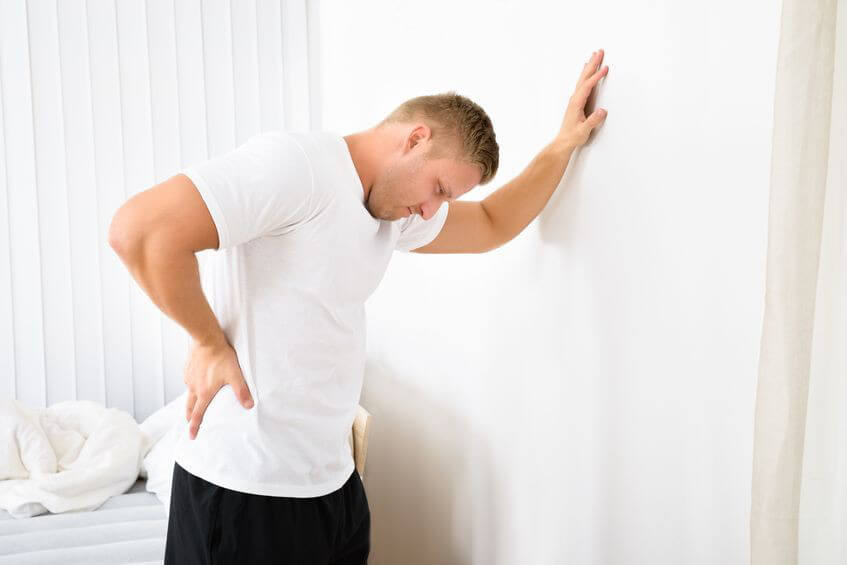You can listen to Sarah’s podcast on this topic here:
The Flexor Reflex and One-Sided Pain
The Flexor Reflex and Injury Recovery
Imagine that you’ve slipped on your icy front steps and sprained your ankle. On top of the fact that you don’t have an exciting mountain climbing story to tell, you have to wear an ankle brace and use crutches for at least a month so that the torn ligaments can heal. You have to put all your weight on your uninjured side, and you instinctively contract and immobilize the injured side in order to protect it.
Over the next four weeks, you get really good at hobbling around on your one good leg. This unnatural way of moving starts to become habitual. Even after your ankle is fully healed, you find yourself standing with your weight shifted to one side and the other hip hiked up.
The Flexor Reflex and Chronic Pain
Now imagine that you have chronic pain in your right shoulder. You’re diagnosed with a torn rotator cuff, a result of years of wear and tear from weight lifting. As the pain increases, you use your shoulder less and less in order to avoid the pain. You also develop the tendency to hold your right arm against your body to limit the movement in your shoulder.
After surgery and months of physical therapy, your pain is finally gone, but your habitual movement pattern remains. The muscles that hold your shoulder in place and pull your arm in toward your body are chronically contracted, and your right shoulder is now an inch lower than your left.
The ways that we adjust our posture and movement in reaction to an injury or chronic pain are largely subconscious. We contract certain muscles to protect the painful or injured area, and modify our movement patterns to avoid the pain. Our pain processing system works with our proprioceptive and vestibular systems to automatically adjust our posture and movement so that we can minimize our pain and prevent further injury.
What is the Flexor Reflex?
When one side of the body is injured or feels pain, such as when we step on a nail or touch a very hot pan, an automatic nervous system response called the flexor reflex is triggered. The flexor muscles on the injured side of the body contract to pull the affected area away from the source of pain. Then the crossed-extensor reflex immediately kicks in, activating the extensor muscles on the opposite side of the body so that our weight remains balanced and we don’t fall over.
The flexor reflex is extremely helpful during acute pain or injury because it helps us avoid pain and further damage to our body. However, when it is activated constantly by chronic pain or a prolonged healing process from an injury, we can easily develop muscular patterns that stay with us permanently. What begins as a protective postural mechanism becomes a habitual muscular pattern, causing misalignment, dysfunctional movement, and further pain.
This reflexive, protective response to injury will always be experienced on one side unless our injury or pain is directly in the center of our body, such as in our abdomen or along our spine. For example, after abdominal surgery we will tend to stand with rounded posture in order to protect our abdomen, which has effectively gone through trauma. Likewise, if our spine is injured our back muscles will tighten up in order to limit movement.
Relieving the Negative Effects of the Flexor Reflex
Thomas Hanna, who developed Clinical Somatic Education, observed the effects of the flexor reflex in his clients. They had tilted and often rotated posture, uneven hips and shoulders, and different patterns of muscular contraction on each side of the body. Many of these clients had scoliosis, sciatica, or pain in their hip, knee, and ankle joints, while others had frozen shoulder, bursitis, or carpal tunnel syndrome.
Some of Hanna’s clients had even been told by doctors that they had one leg longer than the other. This perceived difference in leg length was caused by tight waist muscles hiking one hip up higher than the other. When Hanna taught his clients how to release their oblique muscles, their hips evened out and miraculously, their legs were the same length.
If you’ve read the other two posts in this series, and learned about the effects of the action response, withdrawal response, and now the flexor reflex, you will likely find it difficult not to notice them in everyone you see. You’ll be able to tell who among your friends has back pain simply by observing their tight, arched lower backs. You’ll observe strangers on the street hunched over, their backs and shoulders rounded and their heads sticking forward. You may even look in the mirror and see that one of your shoulders or hips is higher than the other. Don’t worry—these are all functional issues that can be improved and eliminated with the methods of Clinical Somatic Education.
Check out the other two posts in this series about reflexes and posture:
Recommended reading:
The Pain Relief Secret: How to Retrain Your Nervous System, Heal Your Body, and Overcome Chronic Pain by Sarah Warren, CSE
Somatics: Reawakening the Mind’s Control of Movement, Flexibility and Health by Thomas Hanna

